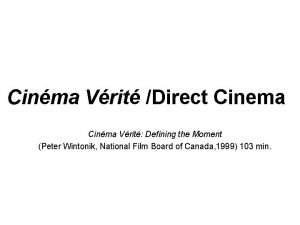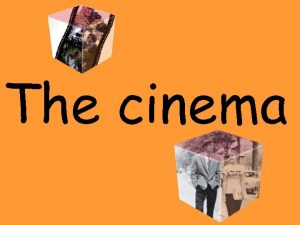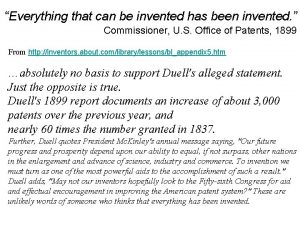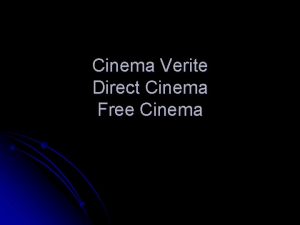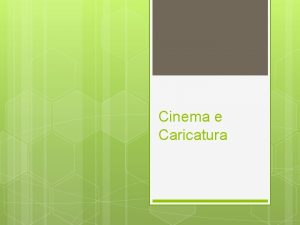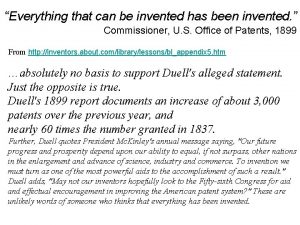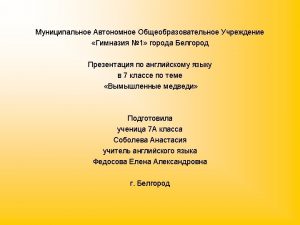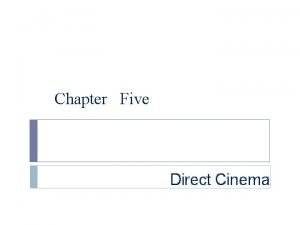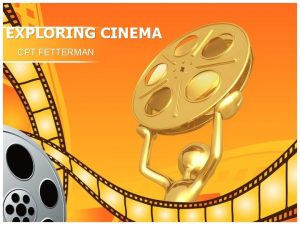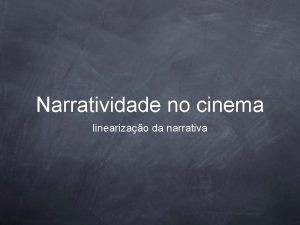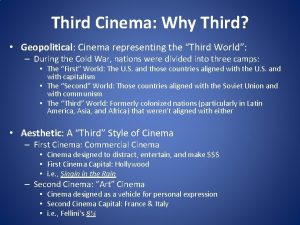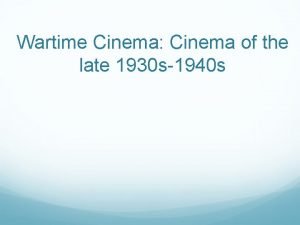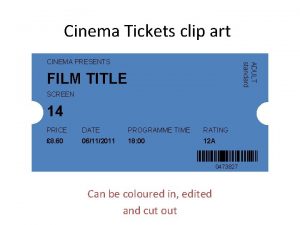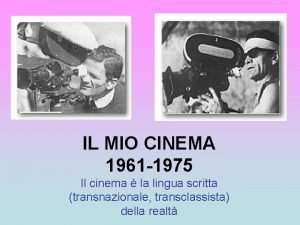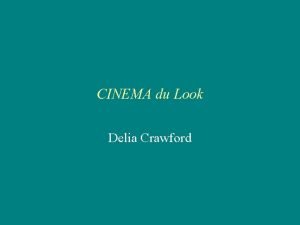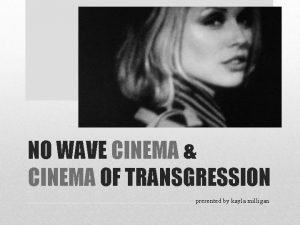The cinema When was the cinema invented It
































- Slides: 32

The cinema

When was the cinema invented? It was invented in Paris on 28 th December 1895, by the brothers Louis and August Lumière.

Who has invented the cinema? The cinema was invented by the Lumière brothers. They produced a single instrument that worked as a camera and a projector, the Cinematographer. It was patented on 13 February 1894. The first film that was shoot with this instrument on 19 March 1895 was “Workers Leaving the Lumière Factory”. The images beat the public with“ The arrival at the La Ciotat station”. Their invention ended when it was sold to Georges Mèlies.

Where was it invented? On 28 December 1895 at “GRAND CAFÉ” of Paris.

How was it invented? For the first time on 28 th/12/1895 Louis and August Lumière exibited their invention to the “Gran café de capucines” in Paris, projecting on a white screen a sequence of distinctive images, already printed with a photographic process. In this way they create the effect of the movement. It was called “appareil servant a l’obtention et a la vision des eprouves cronomatografiques” by the Lumière.

Why was it invented? We can say the cinema started as instrument of scientific surveying, returning back as celebration and diffusion the extraordinary show of science.

Timeline 4)1927, the first sound movie was invented. (Il cantante di jazz) 1)On 28 December of 1895 the cinema was invented. 2)On 15 December of 1905 has been made the old cinema. 3)The first '20 years of the XX century in Los Angeles was invented Hollywood. 5)In the 1930 were invented he new technology (dubbing, sound dubbing) 6)In the '90 years the digital cinema was invented

Timeline of the best Italian Films -1905 La presa di Roma (Filoteo Alberini) -1912 Quo vadis? (Enrico Guazzoni) -1948 Ladri di biciclette (Vittorio De Sica) -1958 I soliti ignoti (Mario Monicelli) -1960 La ciociara (Vittorio De Sica)

Timeline of the best Italian Films -1968 C'era una volta il West (Sergio Leone) -1981 Ricomincio da tre (Massimo Troisi) - 1988 Nuovo Cinema Paradiso (Giuseppe Tornatore) - 1997 La vita è bella (Roberto Benigni) - 2002 La meglio gioventù (Marco Tullio Giordana)

Technical part of the cinema

• Talking cinema Talking films were invented in the first ten years of the XX century. In those years films were followed by live music.

• Digital cinema The arrival of digital films was a real revolution, because after 100 years of story, cinema left its basic simbol: the motion picture.

• Where did it first come? This is a revolution that come from USA and that in Italy started in 2005 in Silea, Pradamano and Trieste.

• How is made a digital film? Film is compressed in a file, after this it’s decrypted and is put in a central server, finally it’s transmitted by a reader; in digital films we can see clear, vivid pictures and an exact suond higher than a motion picture.

Effects of the invention in the modern world

Cinema, literature and art: Futurism In futurism the cinema is analyzed like independent means of expression with remarkable possibilities. Giacomo Balla “Velocità in motocicletta” 1913/1914

U. Boccioni “Forme uniche della continuità nello spazio” G. Balla “Bambina che corre sul balcone” 1912 The experiences of the futurists in the cinema can be connected to the requirement to pick dynamics of the modern times, the movement, the simultaneity, the speed of which the contemporary life it is impregnated.

The Manifest of the 1909 prefigure a cinematographic realization of the provocations already put into effect by futurist with the poetry and theatre: chaotic collision, full freedom from every logical and coherent use; cinema as natural evolution of the painting.

Cinema, literature and art: Neorealism The Neorealism has been a movement developed between 1940 and 1950 that has been expressed above all in novelistic and cinema, particularly in Italy. The neorealists were much influenced by the French poetic realism.

The neorealist cinema is characterized by stories acclimatized between the poor working classes, with long camera takes to the open, often on the background of the war devastations, and often some characters were portrayed by non-actors.

To teach and to learn with the cinema Considering that the children from the most tender age are exposed to images in motion in the schools for decades many initiatives about cinema have been done.

There are three typologies of participation: 1)The vision of films without any analysis 2)Initiatives like matinees in the cinemas in which films are used to start reflections and arguments on several thematic 3)Production of a video with the operators and teacher help. “media literacy“

Newsreel The newsreel is a short film about the present time and information projected in the cinemas before the beginning of the show and characterized by a fast rhythm of the reportages.

The newsreel was invented in France in 1907 diffusing itself in all Europe and the USA. During the second World War it became a powerful instrument of propaganda in all the totalitarian regimes. It disappeared progressively from the cinemas in the course of the 70 s, when the television became a mass media.

In Italy the newsreel of the post-war period diffused new social models of behaviour and represents a more effective vehicle of information than the printed publication paper. The Italian newsreel historically more meaningful and important is represented by that one produced by the Luce Institute between 1927 and 1945.

Globalization could be defined like a reduction of the distances (spatial, cultural, etc. . . ). The cinema has contributed to globalization diffusing behaviours, ideals, lifestyles and conforming the world-wide culture.

CINEMA AND SPECTATORES The teenagers’s world

Children and teenagers love very much cinema tales because cinema stimulate the creativity in the spectator.

Cinematic art is an instrument for the recoup of spontaneity through the identification with the young leading actores.

Unfortunately more children don’t go to the cinema very often, but only sometimes during the holidays.

Films that have more successful on children’s world are: funny films cartoon adventure films

Cinema is a source of education too, in fact cinematic pellicle stimulate the spectator’s immagination and it leave into the young spectator a strong sign.
 Direct cinema vs cinema verite
Direct cinema vs cinema verite Who invented cinema
Who invented cinema Everything that has been invented
Everything that has been invented Has everything been invented
Has everything been invented Lời thề hippocrates
Lời thề hippocrates Vẽ hình chiếu đứng bằng cạnh của vật thể
Vẽ hình chiếu đứng bằng cạnh của vật thể đại từ thay thế
đại từ thay thế Quá trình desamine hóa có thể tạo ra
Quá trình desamine hóa có thể tạo ra Các môn thể thao bắt đầu bằng từ đua
Các môn thể thao bắt đầu bằng từ đua Khi nào hổ con có thể sống độc lập
Khi nào hổ con có thể sống độc lập Thế nào là mạng điện lắp đặt kiểu nổi
Thế nào là mạng điện lắp đặt kiểu nổi Hình ảnh bộ gõ cơ thể búng tay
Hình ảnh bộ gõ cơ thể búng tay Dạng đột biến một nhiễm là
Dạng đột biến một nhiễm là Thế nào là sự mỏi cơ
Thế nào là sự mỏi cơ Phản ứng thế ankan
Phản ứng thế ankan Gấu đi như thế nào
Gấu đi như thế nào Thiếu nhi thế giới liên hoan
Thiếu nhi thế giới liên hoan Fecboak
Fecboak điện thế nghỉ
điện thế nghỉ Một số thể thơ truyền thống
Một số thể thơ truyền thống Trời xanh đây là của chúng ta thể thơ
Trời xanh đây là của chúng ta thể thơ Thế nào là hệ số cao nhất
Thế nào là hệ số cao nhất Sơ đồ cơ thể người
Sơ đồ cơ thể người Ng-html
Ng-html Các số nguyên tố là gì
Các số nguyên tố là gì đặc điểm cơ thể của người tối cổ
đặc điểm cơ thể của người tối cổ Các châu lục và đại dương trên thế giới
Các châu lục và đại dương trên thế giới Chụp tư thế worms-breton
Chụp tư thế worms-breton ưu thế lai là gì
ưu thế lai là gì Tư thế ngồi viết
Tư thế ngồi viết Cái miệng xinh xinh thế chỉ nói điều hay thôi
Cái miệng xinh xinh thế chỉ nói điều hay thôi Mật thư tọa độ 5x5
Mật thư tọa độ 5x5 Các châu lục và đại dương trên thế giới
Các châu lục và đại dương trên thế giới
